广东海洋大学:《兽医内科学》课程教学课件(讲稿)Chapter 3 Diseases of Respiratory System
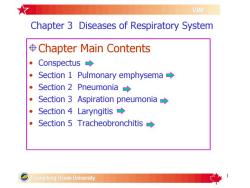
Chapter3DiseasesofRespiratorySystem$Chapter Main ContentsConspectusSection 1 Pulmonary emphysema →Section 2 Pneumonia →Section 3 Aspiration pneumonia Section 4 Laryngitis Section 5 Tracheobronchitis→Guangdong Ocean University
1 Chapter 3 Diseases of Respiratory System Chapter Main Contents • Conspectus • Section 1 Pulmonary emphysema • Section 2 Pneumonia • Section 3 Aspiration pneumonia • Section 4 Laryngitis • Section 5 Tracheobronchitis
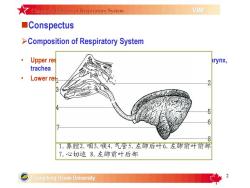
★ Chapter3Diseases of Respiratory SystemVIMConspectus>Composition of Respiratory SystemUpperresarynx,tracheaLowerrese1.鼻腔2.咽3.喉4.气管5.左肺后叶6.左肺前叶前部7.心切迹8.左肺前叶后部Guangdong Ocean University
2 nConspectus • Upper respiratory tract: Nasal cavity, sinuses paranasales(副鼻窦), larynx, trachea • Lower respiratory tract: bronchus, lung ØComposition of Respiratory System
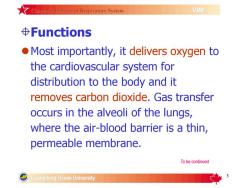
Chaprer3Diseases of Respiratory SystemVIM$FunctionsMostimportantly,itdeliversoxygentothe cardiovascular systemfordistribution to the body and itremovescarbondioxide.Gastransferoccurs in the alveoli of the lungs,where the air-blood barrier is a thin,permeable membrane.To be continuedGuangdong Ocean University
3 Functions lMost importantly, it delivers oxygen to the cardiovascular system for distribution to the body and it removes carbon dioxide. Gas transfer occurs in the alveoli of the lungs, where the air-blood barrier is a thin, permeable membrane. To be continued
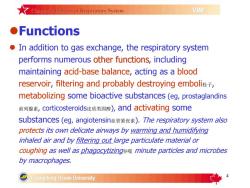
KChapter3Diseases of Respiratory SystemVIMFunctionsInadditiontogasexchange,therespiratorysystemperforms numerousother functions, includingmaintaining acid-base balance, acting as a bloodreservoir,filteringandprobablydestroyingemboli栓子metabolizingsomebioactivesubstances(eg,prostaglandins前列腺素,corticosteroids皮质类固醇),and activating somesubstances (eg,angiotensin血管紧张素). The respiratory system alsoprotects its own delicate airways by warming and humidifyinginhaled air and by filtering out large particulate material orcoughing as well as phagocytizing吞噬 minute particles and microbesby macrophages.Guangdong Ocean University
4 lFunctions l In addition to gas exchange, the respiratory system performs numerous , including maintaining acid-base balance, acting as a blood reservoir, filtering and probably destroying emboli栓子, metabolizing some bioactive substances (eg, prostaglandins 前列腺素, corticosteroids皮质类固醇), and activating some substances (eg, angiotensin血管紧张素). The respiratory system also protects its own delicate airways by warming and humidifying inhaled air and by filtering out large particulate material or coughing as well as phagocytizing吞噬 minute particles and microbes by macrophages
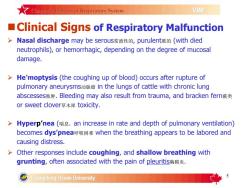
★Chapter3Diseasesof Respiratory SystemVIMClinical Signsof Respiratory Malfunction>Nasaldischargemaybeserous浆液性的,purulent脓的(withdiedneutrophils), or hemorrhagic, depending on the degree of mucosaldamage.>He'moptysis (thecoughingupofblood)occursafterruptureofpulmonary aneurysms动脉瘤in the lungs of cattle withchronic lungabscesses脓肿.Bleedingmayalsoresultfromtrauma,andbrackenfern蕨类orsweetclover草木犀toxicity.Hyperp'nea(喘息,an increaseinrateand depthof pulmonaryventilation)becomes dys'pnea呼吸困难when the breathing appears to belabored andcausingdistress.Other responsesinclude coughing,and shallowbreathing withgrunting, often associated with the pain of pleuritis胸膜炎.Guangdong Ocean University
5 nClinical Signs of Respiratory Malfunction Ø Nasal discharge may be serous浆液性的, purulent脓的 (with died neutrophils), or hemorrhagic, depending on the degree of mucosal damage. Ø He’moptysis (the coughing up of blood) occurs after rupture of pulmonary aneurysms动脉瘤 in the lungs of cattle with chronic lung abscesses脓肿. Bleeding may also result from trauma, and bracken fern蕨类 or sweet clover草木犀 toxicity. Ø Hyperp’nea (喘息,an increase in rate and depth of pulmonary ventilation) becomes dys’pnea呼吸困难 when the breathing appears to be labored and causing distress. Ø Other responses include coughing, and shallow breathing with grunting, often associated with the pain of pleuritis胸膜炎
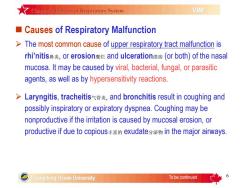
Chapter3Diseases of RespiratorySystemVIMCauses ofRespiratoryMalfunction> Themostcommon cause ofupperrespiratorytract malfunction isrhi'nitis鼻炎,or erosion糜烂andulceration溃疡(orboth)of thenasalmucosa. It may be caused by viral, bacterial,fungal, or parasiticagents,aswell asbyhypersensitivityreactions>Laryngitis,tracheitis气管炎,andbronchitisresultincoughingandpossibly inspiratory or expiratory dyspnea.Coughing may benonproductive if the irritation is caused by mucosal erosion, orproductive if due to copious丰富的 exudate分泌物 in the major airwaysTobecontinuedGuangdong Ocean University
6 n Causes of Respiratory Malfunction Ø The most common cause of upper respiratory tract malfunction is rhi’nitis鼻炎, or erosion糜烂 and ulceration溃疡 (or both) of the nasal mucosa. It may be caused by viral, bacterial, fungal, or parasitic agents, as well as by hypersensitivity reactions. Ø Laryngitis, tracheitis气管炎, and bronchitis result in coughing and possibly inspiratory or expiratory dyspnea. Coughing may be nonproductive if the irritation is caused by mucosal erosion, or productive if due to copious丰富的 exudate分泌物 in the major airways. To be continued
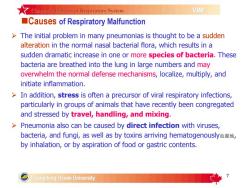
VIMChapter3Diseases of Respiratory SystemCausesof RespiratoryMalfunctionThe initial problem in many pneumonias is thought to be a suddenalteration in the normal nasal bacterial flora, which results in asuddendramatic increasein one ormore speciesof bacteria.Thesebacteria are breathed into the lung in large numbers and mayoverwhelm the normal defense mechanisms, localize, multiply, andinitiate inflammation.Inaddition,stressisoftenaprecursorof viral respiratoryinfectionsparticularly in groups of animals that have recently been congregatedand stressed by travel, handling, and mixingPneumoniaalso can be caused bydirect infection withvirusesbacteria,and fungi,as well asbytoxins arriving hematogenouslyi血源地by inhalation, or by aspiration of food or gastric contents.Suangdong Ocean University
7 Ø The initial problem in many pneumonias is thought to be a sudden alteration in the normal nasal bacterial flora, which results in a sudden dramatic increase in one or more species of bacteria. These bacteria are breathed into the lung in large numbers and may overwhelm the normal defense mechanisms, localize, multiply, and initiate inflammation. Ø In addition, stress is often a precursor of viral respiratory infections, particularly in groups of animals that have recently been congregated and stressed by travel, handling, and mixing. Ø Pneumonia also can be caused by direct infection with viruses, bacteria, and fungi, as well as by toxins arriving hematogenously血源地, by inhalation, or by aspiration of food or gastric contents. nCauses of Respiratory Malfunction
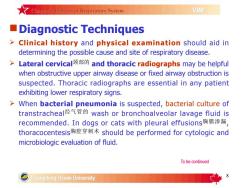
7Chapter3Diseases of Respiratory SystemVIMDiagnosticTechniquesclinical history and physical examination should aid indetermining the possible cause and site of respiratory disease>Lateral cervical颈部的 and thoracic radiographs may be helpfulwhen obstructive upper airway disease or fixed airway obstruction issuspected.Thoracic radiographs are essential in any patientexhibiting lower respiratory signs.> When bacterial pneumonia is suspected,bacterial culture oftranstracheal经气管的 wash or bronchoalveolar lavage fluid isrecommended. In dogs or cats with pleural effusions胸膜渗漏thoracocentesis胸腔穿刺术 should be performed for cytologic andmicrobiologic evaluation of fluid.Tobe continuedGuangdong Ocean University
8 nDiagnostic Techniques Ø Clinical history and physical examination should aid in determining the possible cause and site of respiratory disease. Ø Lateral cervical颈部的 and thoracic radiographs may be helpful when obstructive upper airway disease or fixed airway obstruction is suspected. Thoracic radiographs are essential in any patient exhibiting lower respiratory signs. Ø When bacterial pneumonia is suspected, bacterial culture of transtracheal经气管的 wash or bronchoalveolar lavage fluid is recommended. In dogs or cats with pleural effusions胸膜渗漏 , thoracocentesis胸腔穿刺术 should be performed for cytologic and microbiologic evaluation of fluid. To be continued
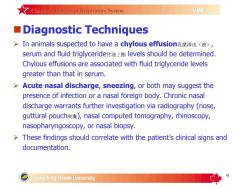
ZChapter3Diseases of Respiratory SystemVIMDiagnostic Technigues>In animals suspected to have a chylous effusion乳糜渗出(液),serum and fluid triglyceride甘油三酯 levels should be determinedChylous effusions are associated with fluid triglyceride levelsgreater than that in serum.Acute nasal discharge, sneezing, or both may suggest the中presence of infection or a nasal foreign body. Chronic nasaldischarge warrants further investigation via radiography (nose,gutturalpouch喉囊),nasal computed tomography,rhinoscopy,nasopharyngoscopy,ornasalbiopsy These findings should correlate with the patient's clinical signs anddocumentation.Suangdong Ocean University
9 nDiagnostic Techniques Ø In animals suspected to have a chylous effusion乳糜渗出(液), serum and fluid triglyceride甘油三酯 levels should be determined. Chylous effusions are associated with fluid triglyceride levels greater than that in serum. Ø Acute nasal discharge, sneezing, or both may suggest the presence of infection or a nasal foreign body. Chronic nasal discharge warrants further investigation via radiography (nose, guttural pouch喉囊), nasal computed tomography, rhinoscopy, nasopharyngoscopy, or nasal biopsy. Ø These findings should correlate with the patient’s clinical signs and documentation
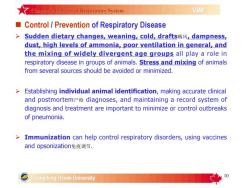
7Chapter3Diseases of Respiratory SystemVIMControl/PreventionofRespiratoryDiseaseSuddendietarychanges,weaning,cold,drafts贼风,dampnessdust,high levels ofammonia,poor ventilationin general, andthe mixing of widely divergent age groups all play a role inrespiratory disease in groups of animals.Stress and mixing of animalsfrom several sources shouldbeavoided or minimized.Establishingindividualanimal identification,makingaccurate clinicalandpostmortem检diagnoses,andmaintaining a recordsystemofdiagnosis and treatment are important to minimizeor control outbreaksofpneumonia.Immunization can help control respiratory disorders, using vaccinesand opsonization免疫调节.10Guangdong Ocean University
10 n Control / Prevention of Respiratory Disease Ø Sudden dietary changes, weaning, cold, drafts贼风, dampness, dust, high levels of ammonia, poor ventilation in general, and the mixing of widely divergent age groups all play a role in respiratory disease in groups of animals. Stress and mixing of animals from several sources should be avoided or minimized. Ø Establishing individual animal identification, making accurate clinical and postmortem尸检 diagnoses, and maintaining a record system of diagnosis and treatment are important to minimize or control outbreaks of pneumonia. Ø Immunization can help control respiratory disorders, using vaccines and opsonization免疫调节
按次数下载不扣除下载券;
注册用户24小时内重复下载只扣除一次;
顺序:VIP每日次数-->可用次数-->下载券;
- 广东海洋大学:《兽医内科学》课程教学课件(讲稿)Chapter 2 Diseases of Digestive System.pdf
- 广东海洋大学:《兽医内科学》课程教学课件(讲稿)Chapter 1 Introduction to VIM.pdf
- 广东海洋大学:《兽医内科学》课程教学资源(教案讲义,共六章,任课教师:陈进军、康丹菊).doc
- 广东海洋大学:《兽医内科学》实验课程教学大纲 Veterinary Internal Medicine.doc
- 广东海洋大学:《兽医内科学》课程实验指导(讲义)实验四 血液丙酮酸的测定.doc
- 广东海洋大学:《兽医内科学》课程实验指导(讲义)实验三 血清谷丙、谷草转氨酶活力测定(赖氏法).doc
- 广东海洋大学:《兽医内科学》课程实验指导(讲义)实验二 氢氰酸的定性与定量检验.doc
- 广东海洋大学:《兽医内科学》课程实验指导(讲义)实验一 血清总钙含量的测定.doc
- 塔里木大学:《兽医临床诊断学》课程实验课教案.docx
- 塔里木大学:《兽医临床诊断学》课程实验教学大纲.pdf
- 塔里木大学:《兽医临床诊断学》课程理论课教案.docx
- 塔里木大学:《兽医临床诊断学》课程教学大纲 Veterinary Clinical Diagnostics.pdf
- 《兽医外科学》课程教学课件(PPT讲稿)第十五章 小动物牙病.ppt
- 《兽医外科学》课程教学课件(PPT讲稿)第十四章 四肢疾病.ppt
- 《兽医外科学》课程教学课件(PPT讲稿)第十三章 跛行诊断.ppt
- 《兽医外科学》课程教学课件(PPT讲稿)第十二章 泌尿生殖系统疾病.ppt
- 《兽医外科学》课程教学课件(PPT讲稿)第十一章 直肠及肛门疾病.ppt
- 《兽医外科学》课程教学课件(PPT讲稿)第七章 头部疾病.ppt
- 《兽医外科学》课程教学课件(PPT讲稿)第八章 枕、颈部疾病.ppt
- 《兽医外科学》课程教学课件(PPT讲稿)第九章 胸腹壁及脊柱疾病.ppt
- 广东海洋大学:《兽医内科学》课程教学课件(讲稿)Chapter 4 Diseases of cardiovascular system.pdf
- 广东海洋大学:《兽医内科学》课程教学课件(讲稿)Chapter 5 Diseases of Urinary system.pdf
- 广东海洋大学:《兽医内科学》课程教学课件(讲稿)Chapter 6 Diseases of the nervous system.pdf
- 西昌学院:《动物遗传学》实验课程教学大纲.docx
- 西昌学院:《家畜解剖学》实验课程教学指导(共十八个实验).doc
- 龙岩学院:《预防兽医学》实验课程教学大纲.docx
- 龙岩学院:《基础兽医学》实验课程教学大纲.docx
- 龙岩学院:《临床兽医学》实验课程教学大纲.docx
- 南京农业大学:《兽医内科学》实验课程教学大纲(强化).doc
- 南京农业大学:《兽医内科学》实验课程教学大纲(动医).doc
- 南京农业大学:《兽医内科学》实验课程教学大纲.doc
- 南京农业大学:《兽医临床诊断学》实验课程教学大纲(动医、实验).doc
- 南京农业大学:《动物解剖学》课程II教学大纲(动医).pdf
- 南京农业大学:《动物解剖学》课程II教学大纲(动物实验).pdf
- 南京农业大学:《宠物解剖学》课程教学大纲.pdf
- 南京农业大学:《中兽医学》实验课程教学大纲.pdf
- 南京农业大学:《兽医药理学》实验课程教学大纲.pdf
- 南京农业大学:《兽医药代动力学》实验课程教学大纲.pdf
- 南京农业大学:《药物化学》实验课程教学大纲.pdf
- 南京农业大学:《兽医毒理学》实验课程教学大纲.pdf
